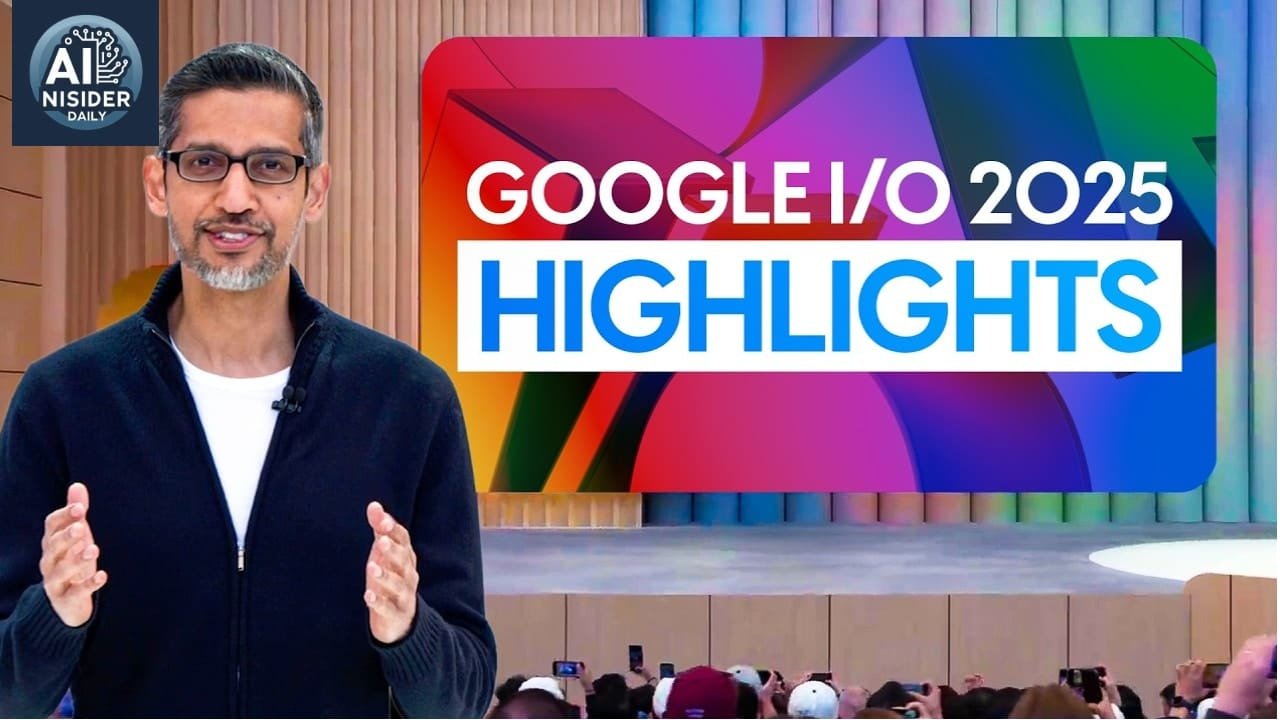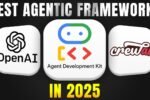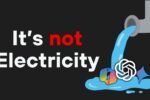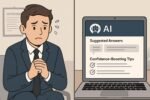AI News: Google IO 2025 Coverage of 20 Game-Changing Announcements
Introduction: Google IO 2025
Google’s annual developer conference, Google IO 2025, has concluded in San Francisco with ground breaking announcements that showcase the company’s commitment to advancing artificial intelligence technology. This year’s theme, “Taking Research into Reality,” emphasized Google’s focus on transforming cutting-edge AI research into practical applications that enhance productivity and efficiency in everyday life.
Our comprehensive coverage breaks down the 20 most significant announcements from the event that will shape how we interact with technology in the coming year.
Video and Media Creation Breakthroughs
1. V3: Revolutionary Video Generation with Integrated Audio
Google unveiled V3, their most advanced video generation model to date. Unlike any existing tool on the market, V3 can generate ultra-realistic videos with accurate real-world physics while simultaneously creating matching audio elements including background sounds, sound effects, and dialogue. This integrated approach eliminates the need for separate audio tools, streamlining the creative process.
The quality of V3’s output was dramatically demonstrated during the keynote as Google revealed that the IO launch video itself was created using V3, showcasing its remarkable capabilities in producing cinema-quality content.
🔍 How to Access Veo 3 – Google’s AI Video Generation Tool
Currently, Veo 3 is accessible through the following platforms:
1. Gemini App
Available to Ultra subscribers in the United States, Veo 3 is integrated into the Gemini App, making high-quality AI video generation accessible to individuals and creators.
Referenced by: The Times of India, Gadgets 360, Google Blog
2. Flow
Flow is Google’s newly introduced AI filmmaking platform, designed for creatives to build cinematic experiences using Veo 3’s ultra-realistic video + audio capabilities.
Referenced by: Google Cloud
3. Vertex AI
For enterprise users, Veo 3 is available via Google’s Vertex AI platform, allowing businesses to integrate powerful video generation capabilities into their workflows.
Official docs: Google Cloud Vertex AI Video Generation
2. Image Gen 4: Google’s Answer to Leading Image Generators
Image Gen 4 represents Google’s latest advancement in AI image generation technology, positioned as a direct competitor to ChatGPT’s image generator. Early demonstrations highlight its impressive ability to accurately render text within images, apply consistent artistic styles, and produce high-quality visuals from simple text prompts.
3. Flow: Next-Generation Movie Creation Platform
Perhaps the most ambitious announcement was Flow, a comprehensive application that leverages both V3 and Image Gen 4 to enable users to create complete movie scenes and storyboards. Flow offers intuitive capabilities for extending scenes, making selective edits, and modifying specific elements seamlessly within a cohesive storytelling environment.
The application promises to revolutionize visual storytelling for content creators, providing professional-grade tools with unprecedented accessibility.
4. Lirya 2: Advanced Music Generation Model
Google’s music generation model, Lirya 2, made a strong impression with a demonstration featuring renowned composer Shankr Madean, who created original compositions using the AI tool without requiring technical AI knowledge. This showcase effectively illustrated Google’s commitment to making advanced AI tools accessible to professionals in creative fields.
E-Commerce and Shopping Innovations
5. Agentic Checkout: Automated Shopping Assistant
Google’s Agentic Checkout represents a significant advancement in e-commerce automation. The system monitors product prices and notifies users of drops for items they’re interested in. When users receive these notifications, they can initiate a streamlined checkout process with a single click, as the system automatically adds the item to cart in the appropriate size based on personal context and completes the purchase via Google Pay.
6. Virtual Try-On Technology
Complementing the checkout experience, Google introduced an advanced virtual try-on feature that utilizes Gemini’s multimodal capabilities. Users can upload a full-body image and select garments they’re interested in, and the system accurately superimposes the clothing onto their image with precise fitting calculations. The technology accounts for body structure and cloth physics to create realistic visualizations of how garments would look when worn.
Wearable and Display Technology
7. Android XR Glasses: The Return of Smart Eyewear
Learning from the lessons of Google Glass, the company announced Android XR glasses, developed in partnership with Warby Parker and other eyewear manufacturers. These glasses function as a 24/7 visual assistant, allowing Gemini to see what the user sees and provide contextual information and guidance.
Key features include object memory (helping locate misplaced items), visual navigation with projected directions, and continuous visual context awareness. This represents Google’s renewed commitment to bringing augmented reality into everyday wearable technology.
8. Google Beam: Next-Generation Video Conferencing
In collaboration with HP, Google introduced Beam, the commercial evolution of Project Starline. This specialized display incorporates three strategically positioned cameras to create a three-dimensional understanding of participants, generating a high-fidelity 60Hz representation that appears remarkably lifelike to remote viewers.
Beam aims to bridge the gap between virtual and in-person meetings by creating a sense of physical presence that conventional video conferencing solutions cannot match.
Search and AI Assistants
9. Google Search AI Mode
Google is transforming its core search product with a new AI-powered mode built on Gemini 2.5. This enhanced search experience can analyze hundreds of websites simultaneously, delivering highly relevant results with personal context awareness. A notable “deep research” feature aggregates information from numerous sources to present comprehensive answers in a single search, positioning Google’s offering as a direct competitor to specialized AI research tools like Perplexity.
10. Gemini Agent Mode
Expanding Gemini’s capabilities beyond conversation, Agent Mode enables the assistant to navigate websites and complete complex tasks on behalf of users. For example, it can search for apartments matching specific criteria by accessing real estate websites, applying filters, and returning optimized results directly within the Gemini app.
11. Project Mariner Upgrades
Google’s agentic AI system, Project Mariner, received significant enhancements, including the ability to run 10 concurrent tasks and integration with the Gemini API. A standout new feature is “teach and repeat,” allowing users to demonstrate workflows once and have the system replicate them automatically—ideal for recurring tasks like invoice generation, email campaigns, or design work.
12. Project Astra and Gemini Live
Building on the visual recognition capabilities previously available in Google AI Studio, Project Astra brings enhanced visual understanding to Gemini Live. Users can show objects through their camera and receive detailed, contextual information about what’s being viewed. The system can identify objects, troubleshoot issues, and even correct misidentifications through reasoning—functioning similarly to the technology in Android XR glasses but through smartphone cameras.
AI Model and Technology Advancements
13. Gemini 2.5 Model Family
Google expanded its Gemini model lineup with several new variants:
- Gemini 2.5 Flash and Flash Light: Faster models with comparable capabilities to previous versions
- Gemini 2.5 Pro Deep Thinking: A specialized model optimized for advanced reasoning, mathematics, coding, and multimodal tasks
The Gemini 2.5 family currently leads benchmark rankings on LM Arena, demonstrating Google’s continued investment in foundational AI model development.
14. Synth ID: Invisible Watermarking
To address concerns about AI-generated content, Google introduced Synth ID, an invisible watermarking technology embedded in all AI-generated media from Google tools. The company revealed that over 10 billion pieces of Gemini-generated content currently circulating online already contain this watermark, enabling identification of AI-created materials.
15. Gemini Text Diffusion
In a surprising technical development, Google announced it has applied diffusion technology—typically used for image generation—to text creation. Gemini Text Diffusion reportedly produces code and solves mathematical problems more efficiently than traditional language model approaches, representing an interesting crossover of AI methodologies.
Developer Tools and Productivity
16. Stitch: No-Code App Development
For non-technical users looking to build applications, Google introduced Stitch, an end-to-end solution that transforms text prompts into functional applications. The process moves from text descriptions to wireframes and prototypes, then to editable Figma-like designs with distinct element IDs, and finally to deployable code—all within a single platform.
If you’re exploring the latest AI tools from Google IO 2025, you might also be interested in how to use Lexis AI to streamline your workflow.
17. Jules Coding Agent
Competing with GitHub Copilot and similar tools, Jules Coding Agent can generate entire codebases from descriptions or work with existing code repositories. The tool understands context across large codebases and facilitates rapid application development through natural language instructions.
18. Gemini in Chrome
Google integrated Gemini directly into Chrome as an accessible assistant for web browsing. Users can activate Gemini with a button press to ask questions about webpage content, schedule appointments, or perform tasks that leverage Google’s suite of services—all without leaving their current browsing session.
Communication and Accessibility
19. Google Meet Live Translation
Breaking down language barriers, Google Meet now offers live translation capabilities that convert spoken language to text in real-time. The system can detect the language being spoken, translate it to a common language (such as English) for reading, and similarly translate responses—enabling conversations between people who share no common language.
Pricing and Availability
20. Google AI Pricing Structure
Google announced a tiered pricing model for access to their advanced AI tools:
- A $20 per month plan providing access to V2 and various AI tools
- Google AI Ultra at $250 per month, offering comprehensive access to cutting-edge technologies including V3, Image Gen 4, Flow, and advanced agentic capabilities
Conclusion
Google IO 2025 demonstrated the company’s comprehensive strategy to integrate advanced AI capabilities across its product ecosystem while simultaneously positioning itself competitively against specialized AI tools in the market. With these announcements, Google has signaled its intention to consolidate AI functionality within its suite of services, potentially reshaping how users interact with technology across creative, professional, and everyday contexts.
The emphasis on transforming research into practical applications suggests Google is focused on making increasingly complex AI technology accessible and useful to general consumers and professionals alike, regardless of their technical expertise.
This article was adapted from coverage of the Google IO 2025 event. For more technology news and updates, subscribe to our newsletter.

